Day 3 of a 3-day Autumn Tour, and we were heading up to the Wash for the Wader Spectacular today. It was a very grey start, and we had some blustery drizzle on and off for an hour or so in the morning which was not in the forecast, before the sun finally came out. There were forecast thunderstorms in the afternoon, and we could see them away to the west of us as we were finishing up. Thankfully we were on our way back in the minibus as we drove into some torrential rain.
It was an early start, to get up to the Wash in time for the high tide this morning, and the sunrise was just visible through the clouds as we got out to the seawall. There was still quite a lot of mud still visible from here at first, so we stopped to scan. A large group of Oystercatchers was gathered away to the north, by the sailing club, with a smaller number of Bar-tailed Godwits and Redshanks, which we got in the scope.
There were more Oystercatchers in a big black slick away to our left, and some grey flocks of Knot spread out over mud. There didn’t seem to be so many Knot in view initially as we have seen here recently, but we soon realised why when a huge flock came up in the distance. They were currently roosting further round the edge of the saltmarsh out of view.

There were fewer small waders on the close mud on the near side of the channel today, so we set about scanning through the birds feeding on the far side of the channel. There were a few more Dunlin here and lots of Redshank, but they were moving fast ahead of the water which was coming in very quickly now. We managed to find a Curlew Sandpiper in with them, a juvenile. We got it in the scope but it was hard to keep track of, disappearing from view down into the shallow pools, and on the move constantly, before it eventually flew and we lost it.
The Oystercatchers and Bar-tailed Godwits peeled up in waves from over by the sailing club, flying low over the water past us and mostly landing on the drier mud higher up. Some of the Oystercatchers gave up already, and continued in over the path, dropping down onto the Pit to roost.
The tide had passed us now already, so we started to walk down the seawall to try to keep pace with it. A Turtle Dove flew in over the pit ahead of us, across the track and looked like it might land on the beach before it doubled back the way in had come and landed in the top of a hawthorn the other side of the water. We got it in the scope and could see its rusty-scaled back and the black and white barred patch on the side of its neck. We couldn’t afford to stay too long, as we had to keep up with the hide, and as we walked on two more Turtle Doves flew up from the vegetation below the bank and disappeared off over the pit.

It was very grey and rather breezy up on the seawall at first, but as we walked down the seawall we could see some darker clouds approaching over the Wash. A rainbow appeared – at first we could only see the two ends of it separately, then it grew complete before turning into a double rainbow. It was very impressive but of course it meant one thing – the rain was upon us! It was light and drizzly, although rather blustery, so we walked on down to Rotary Hide, thinking we could take shelter if need be.

All the waders out on the Wash erupted and started to swirl round in the drizzle out over the water. There were huge numbers of Knot now and they started to make some impressive patterns in the sky. Scanning across, we spotted the cause – a Peregrine was chasing back and forth through them. After a while, the Peregrine seemed to lose interest and broke off from pursuing the flocks. As it flew low over the mud, it suddenly turned sharply and dropped down, grabbing something from the surface.
As it flew off, we could see the Peregrine had something in its talons, though we couldn’t make out what it was. It flew in and landed on the beach – we adjusted our position so we could see it around the bushes and set up the scope on it, but unfortunately it took off again before everyone could get a good look at it, heading back out over the mud before turning back in and disappeared behind the Pit.

We turned our attention back to the waders out on the mud. The tide was still coming in very quickly and the Oystercatchers were walking away from the rising water, the flock appearing to flow over the mud like an amorphous slick, but through the scope we could see the individual birds marching in lines. Always a great part of the spectacle to watch.
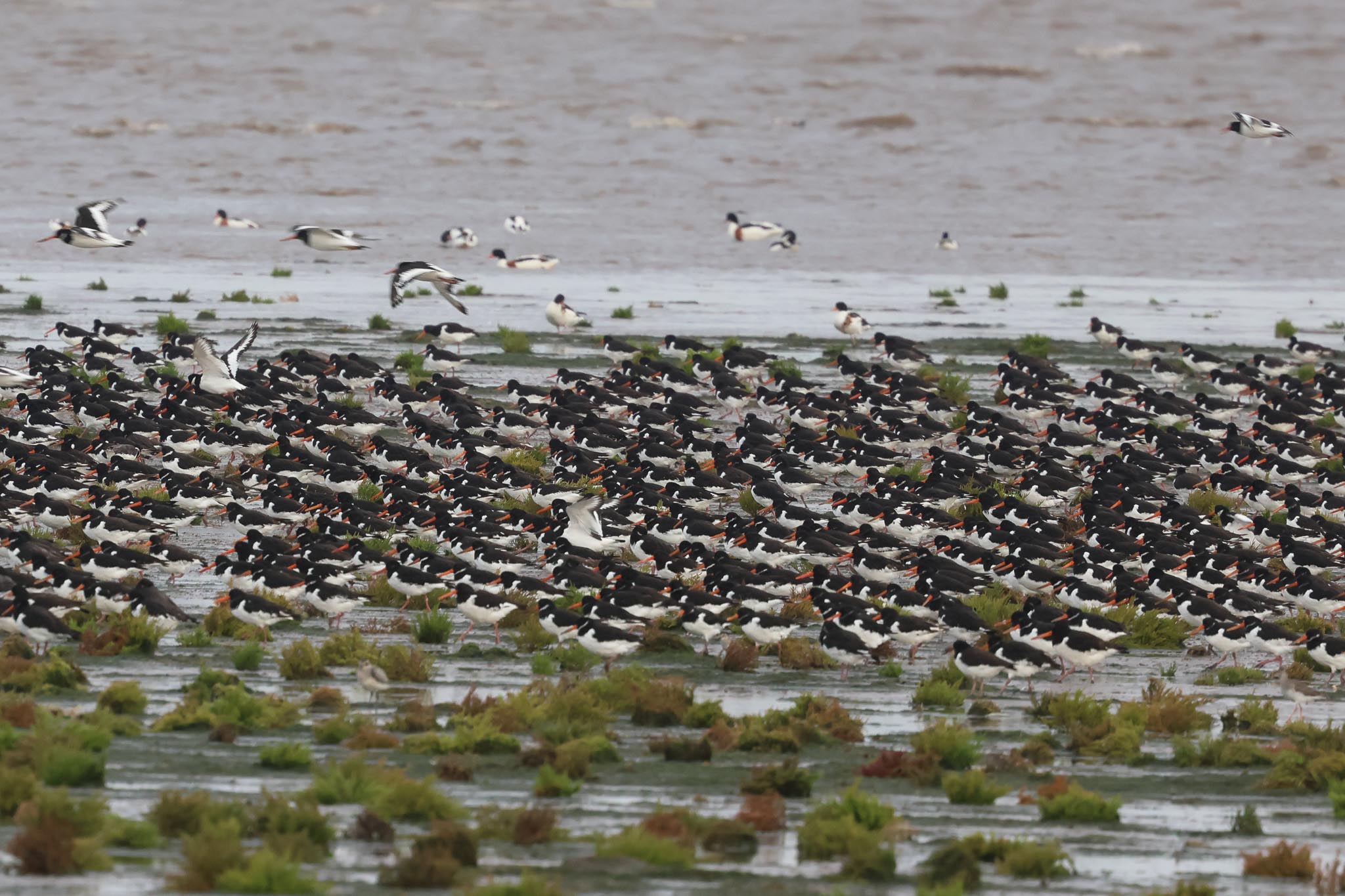
The rain had eased off, so we continued our way down, but another squally shower blew in so we hastened our pace and walked briskly down to the end. We could see some slightly brighter sky heading our way, and after we arrived, it thankfully wasn’t long before the drizzle stopped. The Oystercatchers were now packed more tightly into the remaining area of mud along the near edge of the saltmarsh, continuing to walk away from the water. Some of them started to take off in small groups and fly in over us, piping noisily, and we thought they would continue to do so as they normally do, but today most of them continued to march back into the last remaining corner of mud.
The Knot which had gathered out over view further round the edge of the Wash took off now, and flew in, landing with the others already packed quite tightly into a vast grey flock on the last uncovered mud. They were getting very nervous now and several times they erupted, tens of thousands of birds bursting into the air. The first couple of times, they settled back down very quickly, but as the area of mud shrank and they squeezed in ever tighter, then they took off and started to whirl round over the water, making some impressive shapes in the air, before they eventually all landed again.

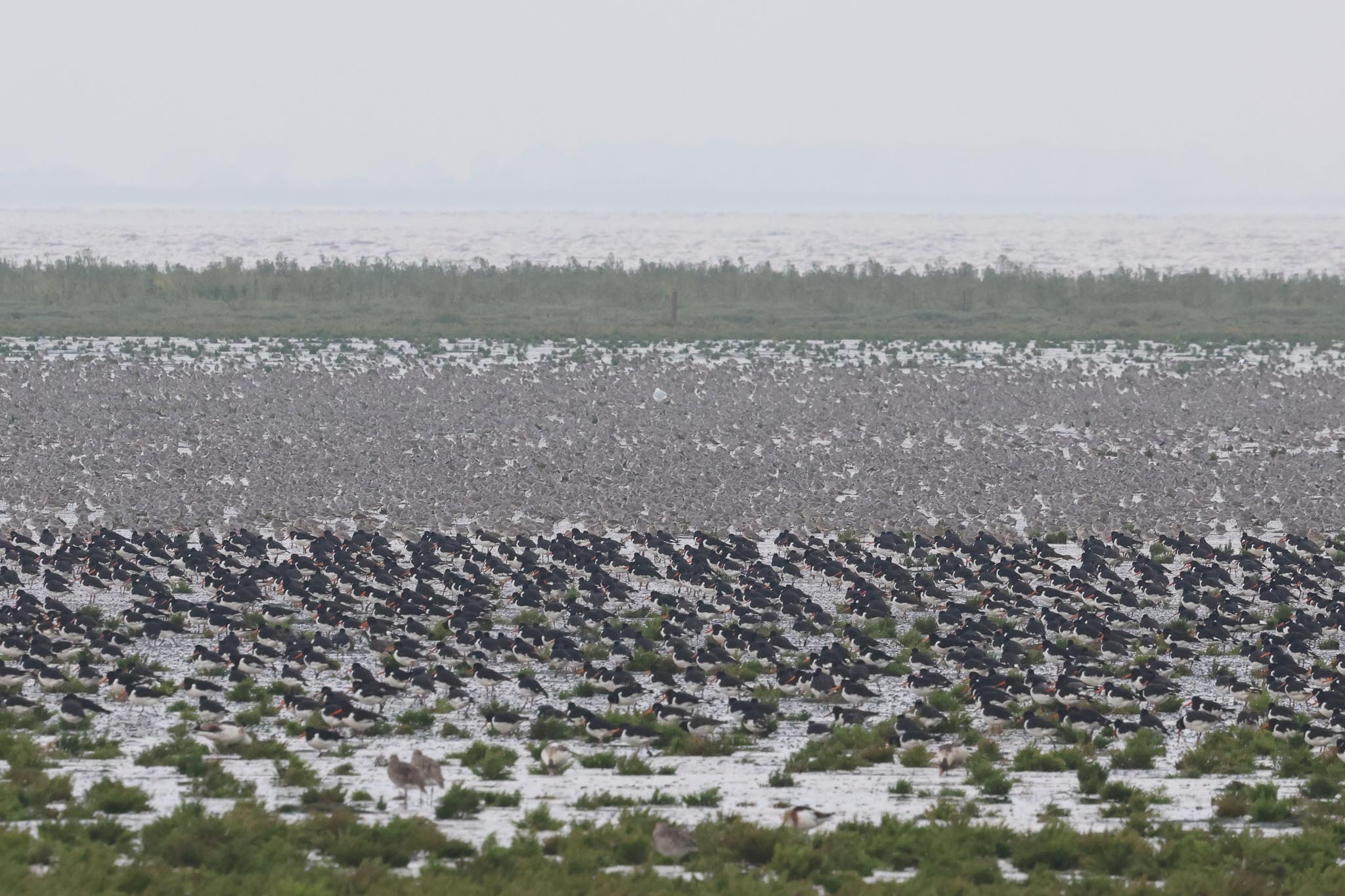

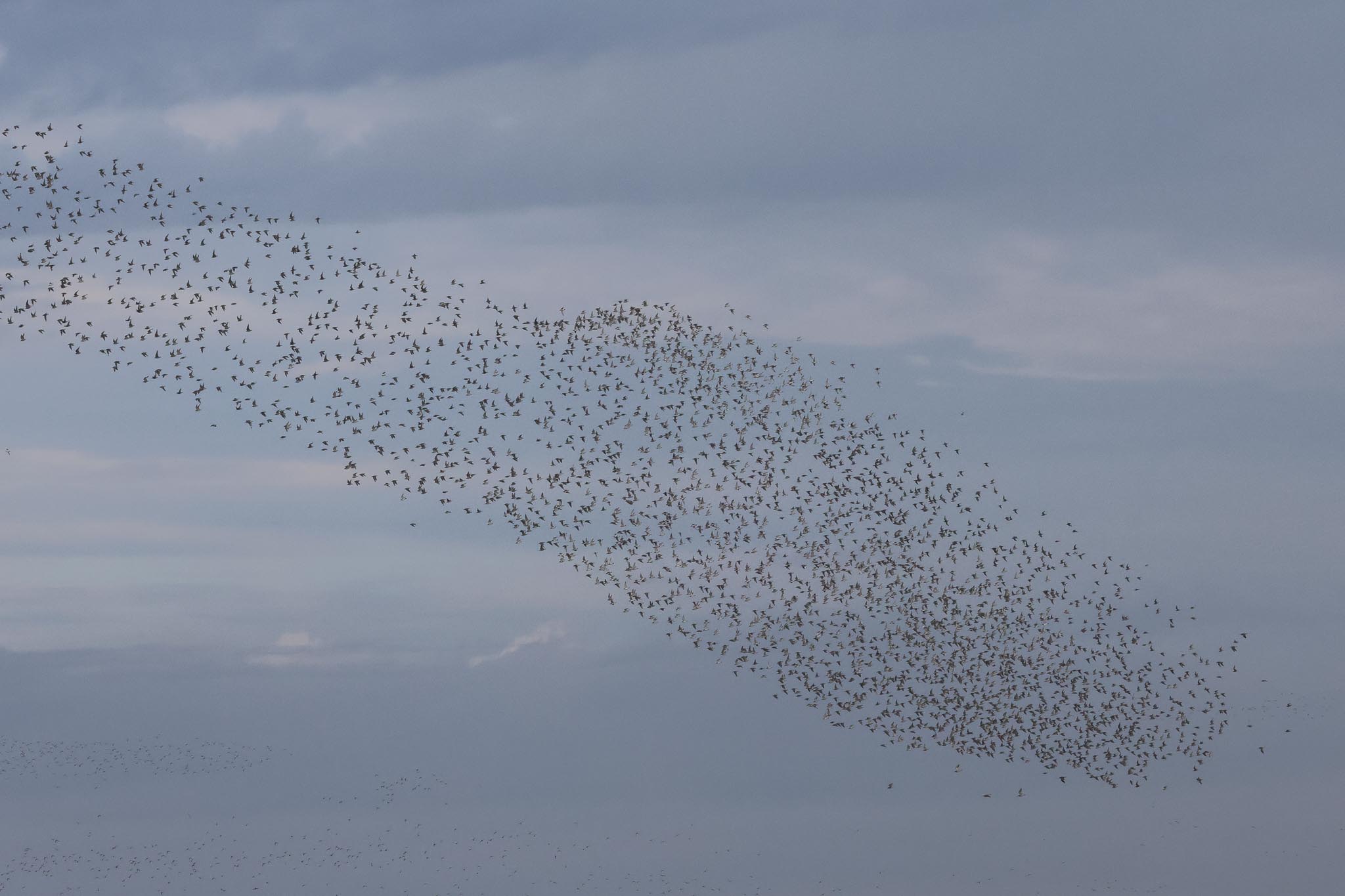
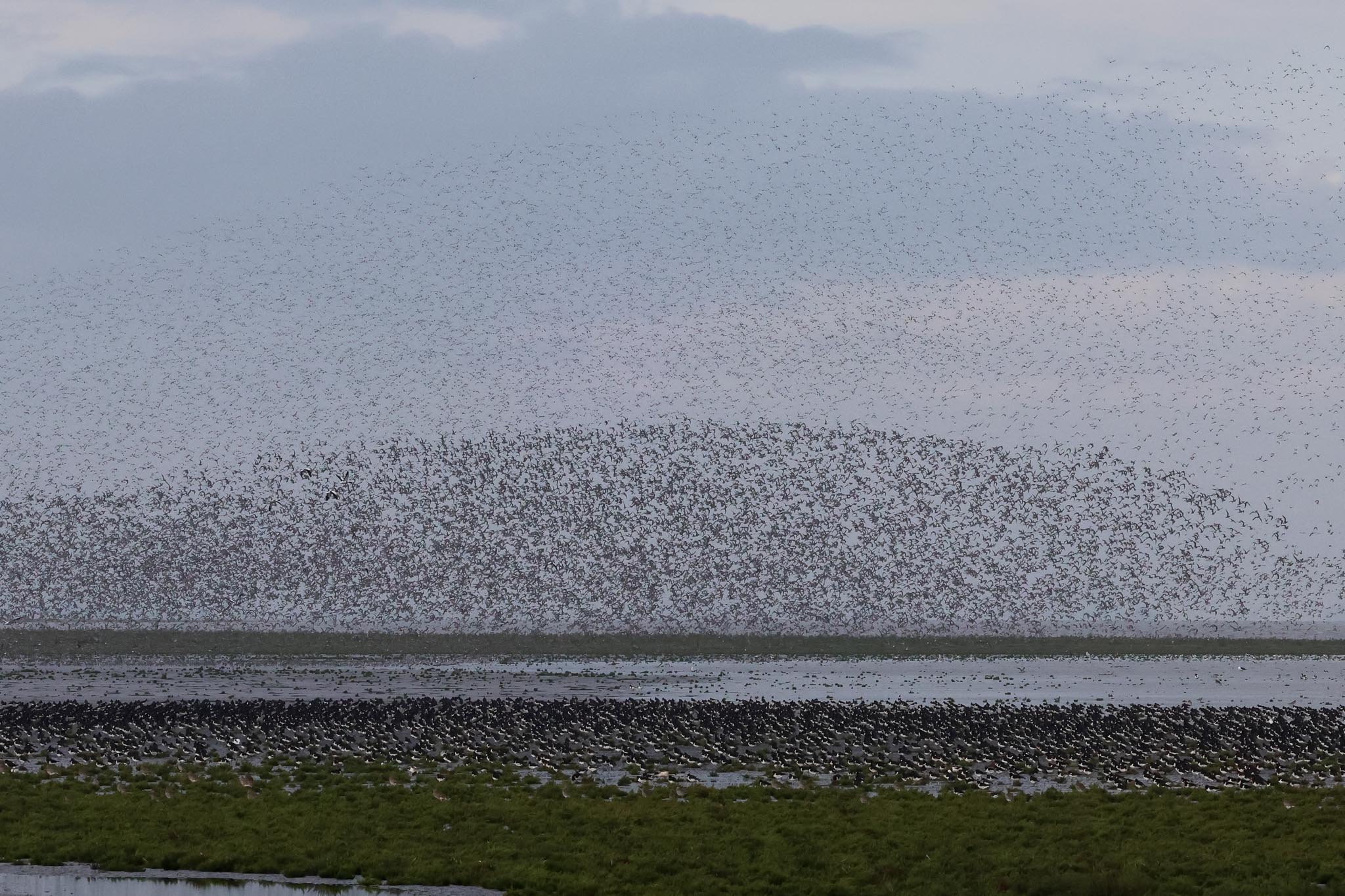
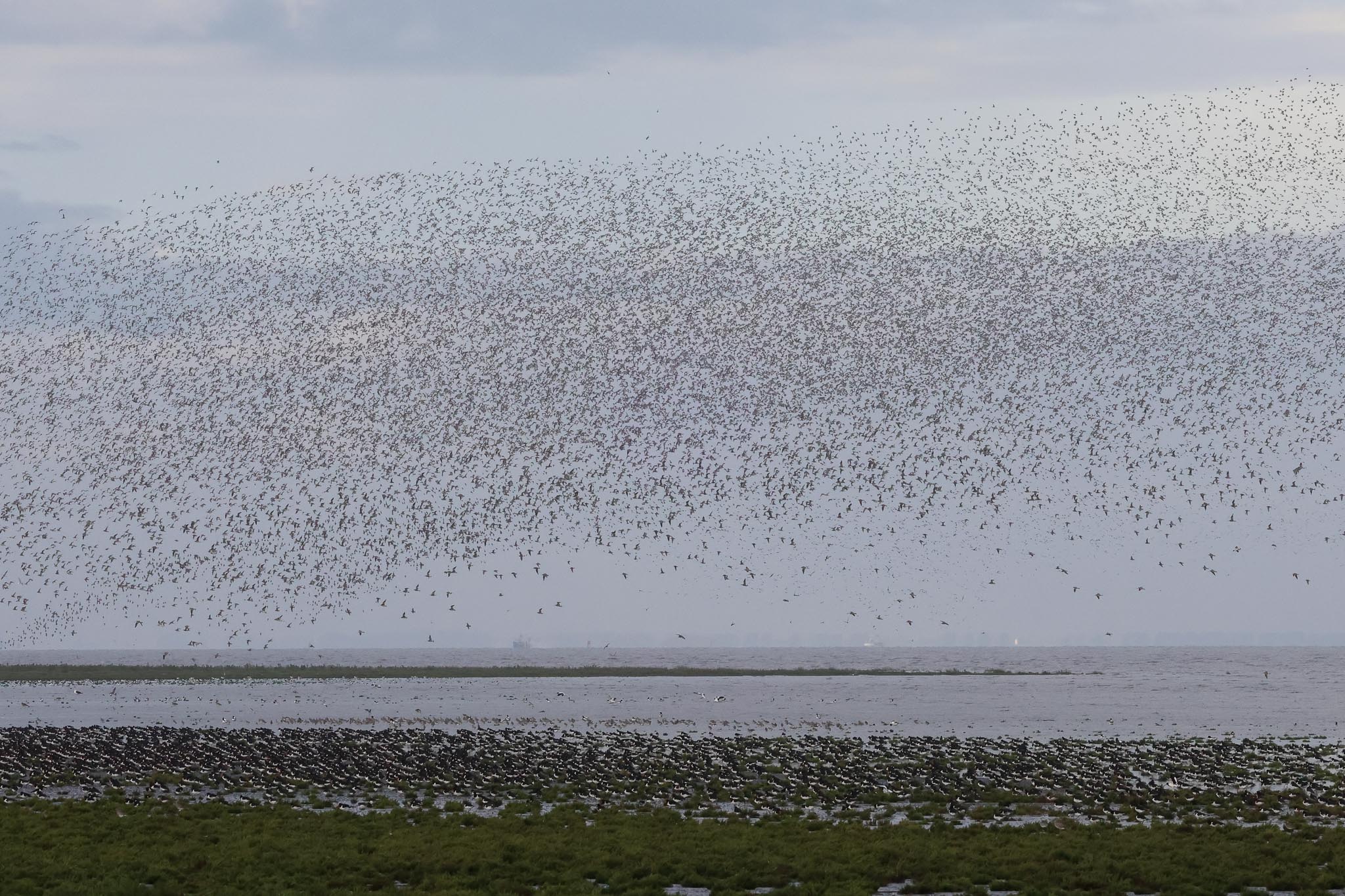
There was a brisk SSW wind, and as we approached high tide, it became clear that the wind was holding back the tide enough to stop it from covering the very last corner of the mud. Still, we thought the Knot would come in to the Pit to roost, as a large part of the flock were now up to their bellies in water. Strangely, all the Oystercatchers were packed into the last corner of mud too today, and they all stayed resolutely put. The sun came out now and they looked even more impressive packed in so tightly in the low sunshine.
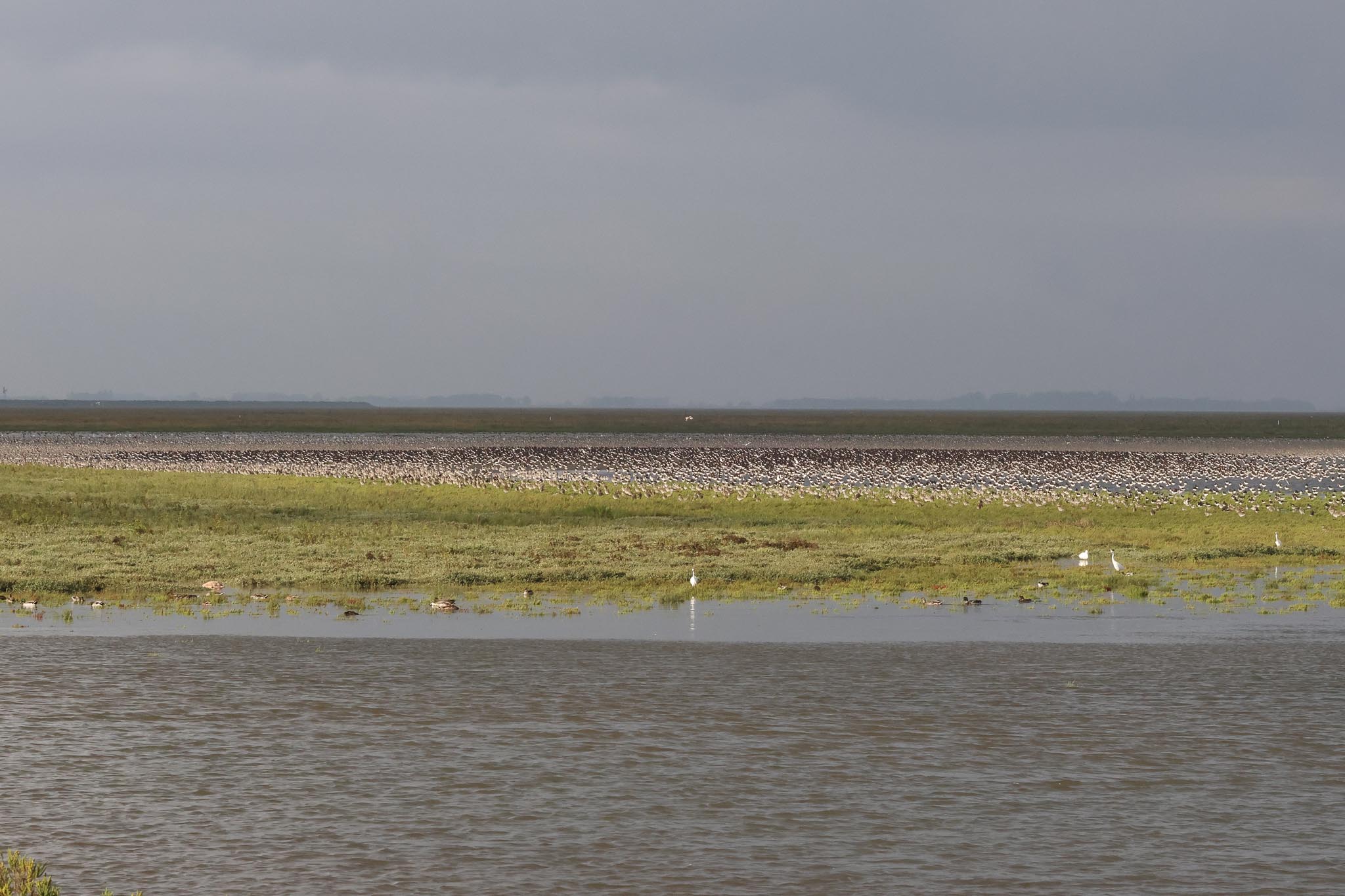
We could see a couple of Marsh Harriers quartering over the saltmarsh beyond and eventually one drifted in too close, flushing all the Knot again. An impressive sight and sound as they all took to the air and the flocks flew back and forth low over the mud, but once again, they settled back down to roost out on the Wash.
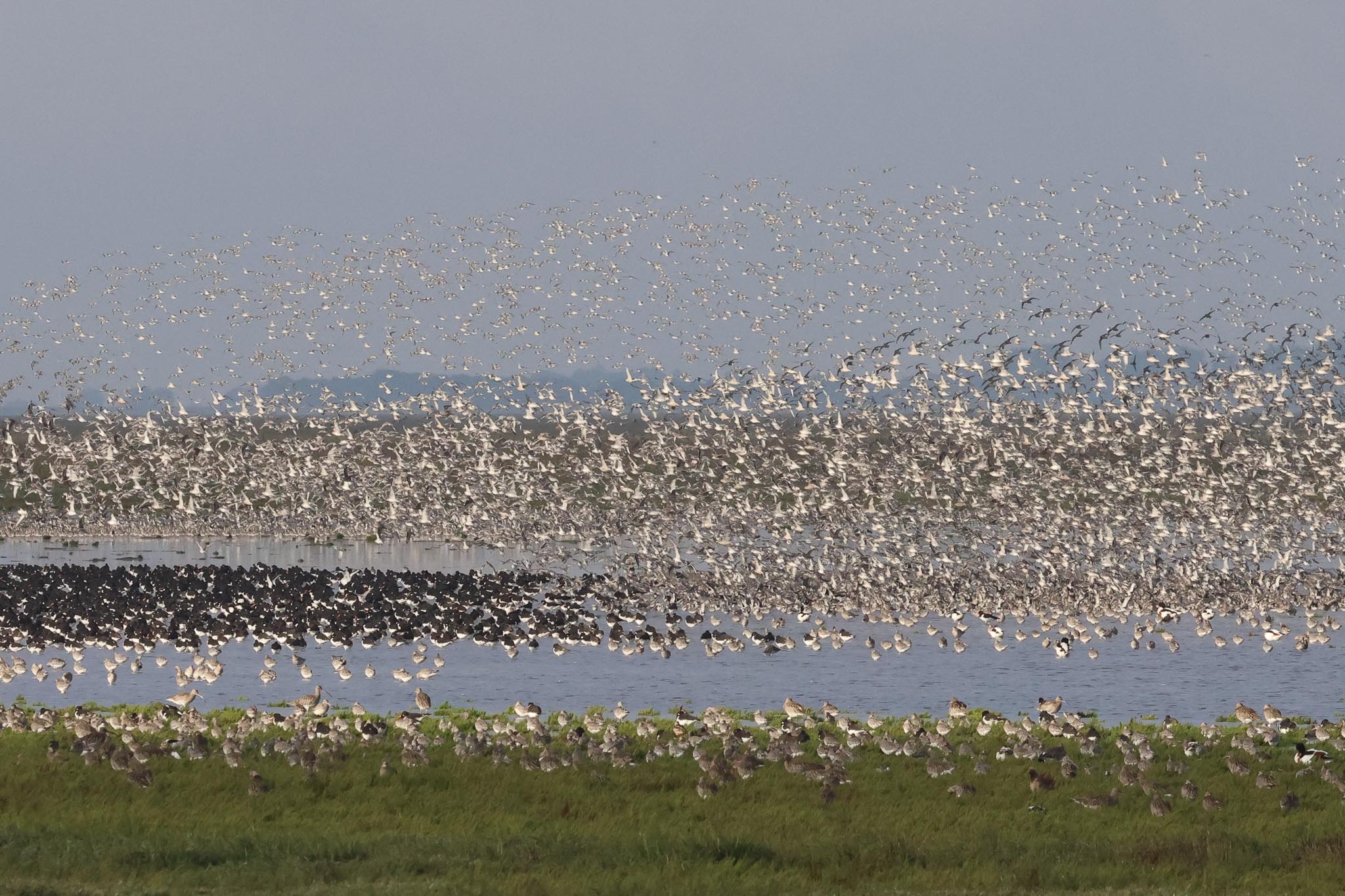
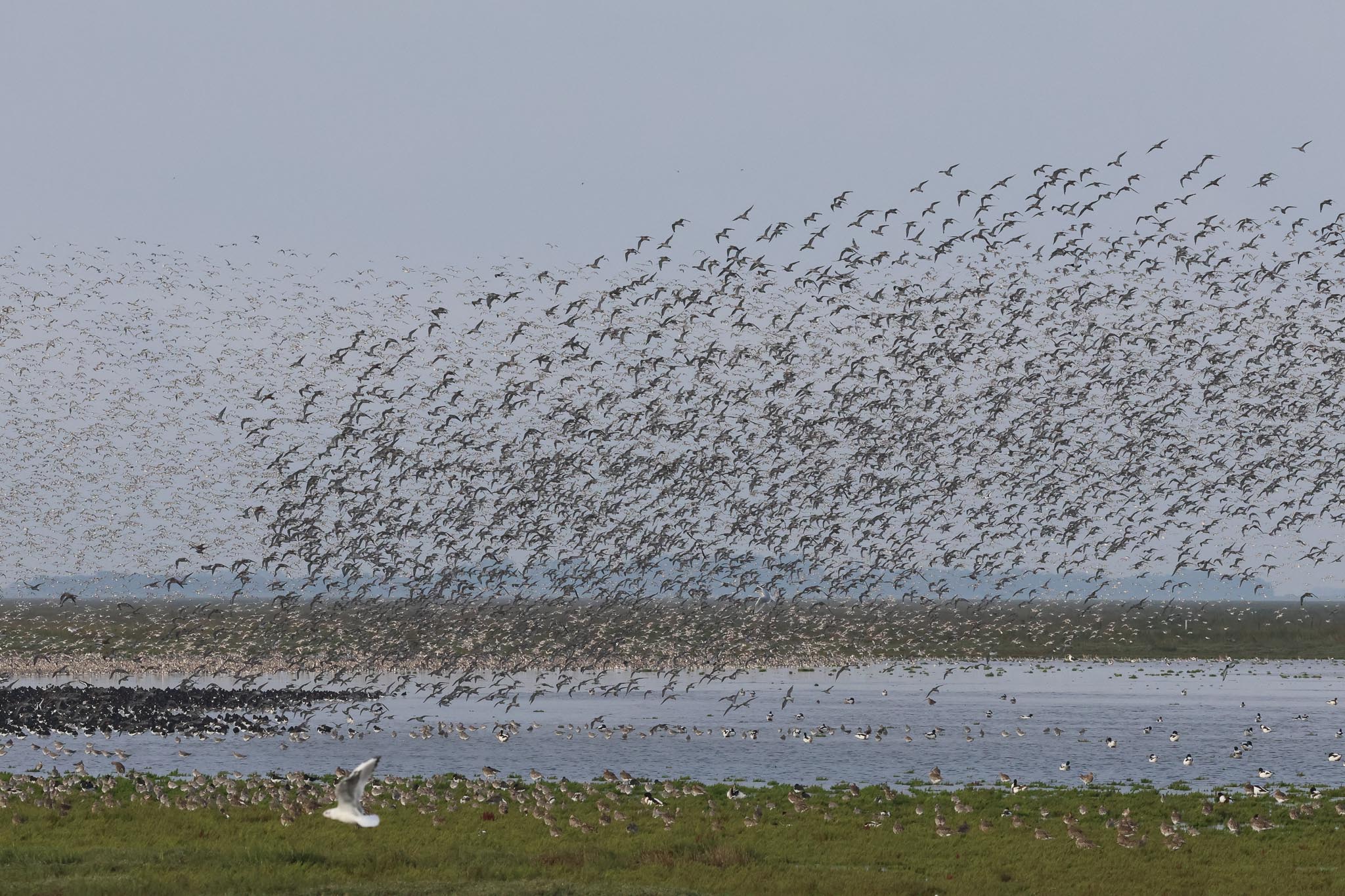
Three Common Sandpiper flew round low over the water in front of us before landing on the top of some low suaeda bushes which were sticking up out of the Wash. There were a few Wigeon swimming around the edges of the bushes and lots of Shelduck now gathered a little further out. A Brent Goose swam in towards us and walked out onto the beach – there are two which have spent the summer here, unable to fly back to Russia for the breeding season with the others, but despite looking not in the best of health they have both survived.
We decided to have a quick look in Shore Hide, and it quickly became apparent what one of the problems was. The water level in the Pit was significantly higher now than when we were last here, after some heavy rain in the last couple of weeks. It also hadn’t gone down as much over the wet summer in 2023 as it sometimes does. As a result, the islands on which the waders normally roost had shrunk considerably. The island which many of the Knot normally like to roost on, as well as being much smaller, was now taken up by the Black-tailed Godwits and Redshanks, which had moved here from the islands at the other end of the Pit. There wasn’t really anywhere for the Knot to go!
There were ten Spoonbills roosting in the rocks in the middle, out from the hide, and just behind them eight Spotted Redshanks roosting with a single Common Redshank alongside. When the Spotted Redshanks woke up, we could see their longer, needle-fine bills and compare the Common Redshank’s.
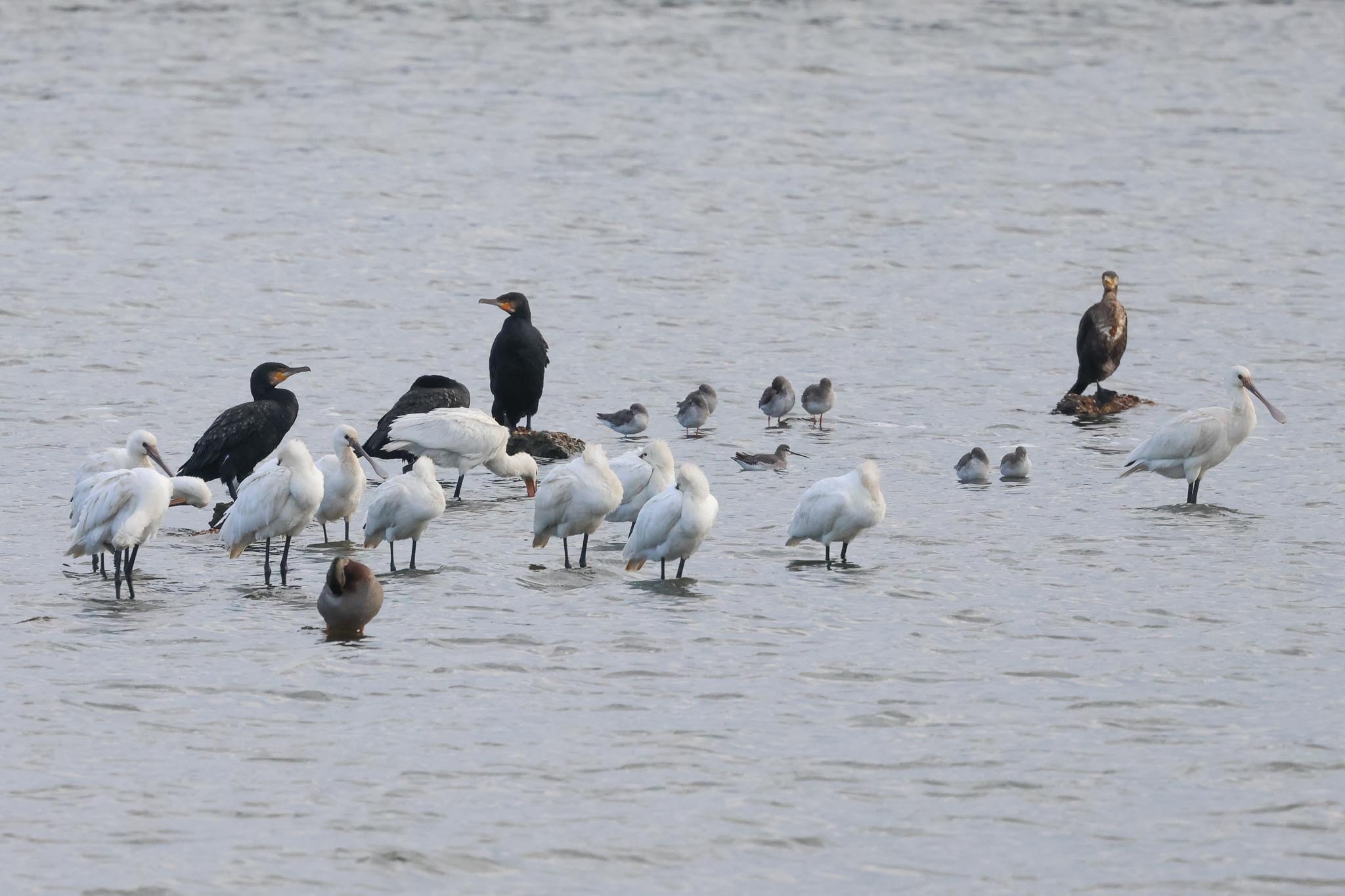
Scanning through the waders on the island, we could see there were a few Turnstones and Knot in with the Black-tailed Godwits. As they were much smaller, they were quite hard to see. Then, as the flock shifted a little, we noticed a Curlew Sandpiper towards the back. It was nigh on impossible to see at first, but eventually as things settled down, we found we could just pick it out through a narrow ‘v’ between some of the godwits.
As we walked back out to the Wash, our timing was impeccable. A young Peregrine put all the Knot up and we watched as they whirled round in the sunshine. The Peregrine probably didn’t know what it was doing and quickly gave up, but as it flew off over the saltmarsh it stooped down at a Marsh Harrier in the bushes. As it had a go at it, two more Marsh Harriers appeared and then an adult Peregrine. The juvenile Peregrine talon grappled first with one of the Marsh Harriers, then with the other Peregrine, before they all drifted away in different directions.
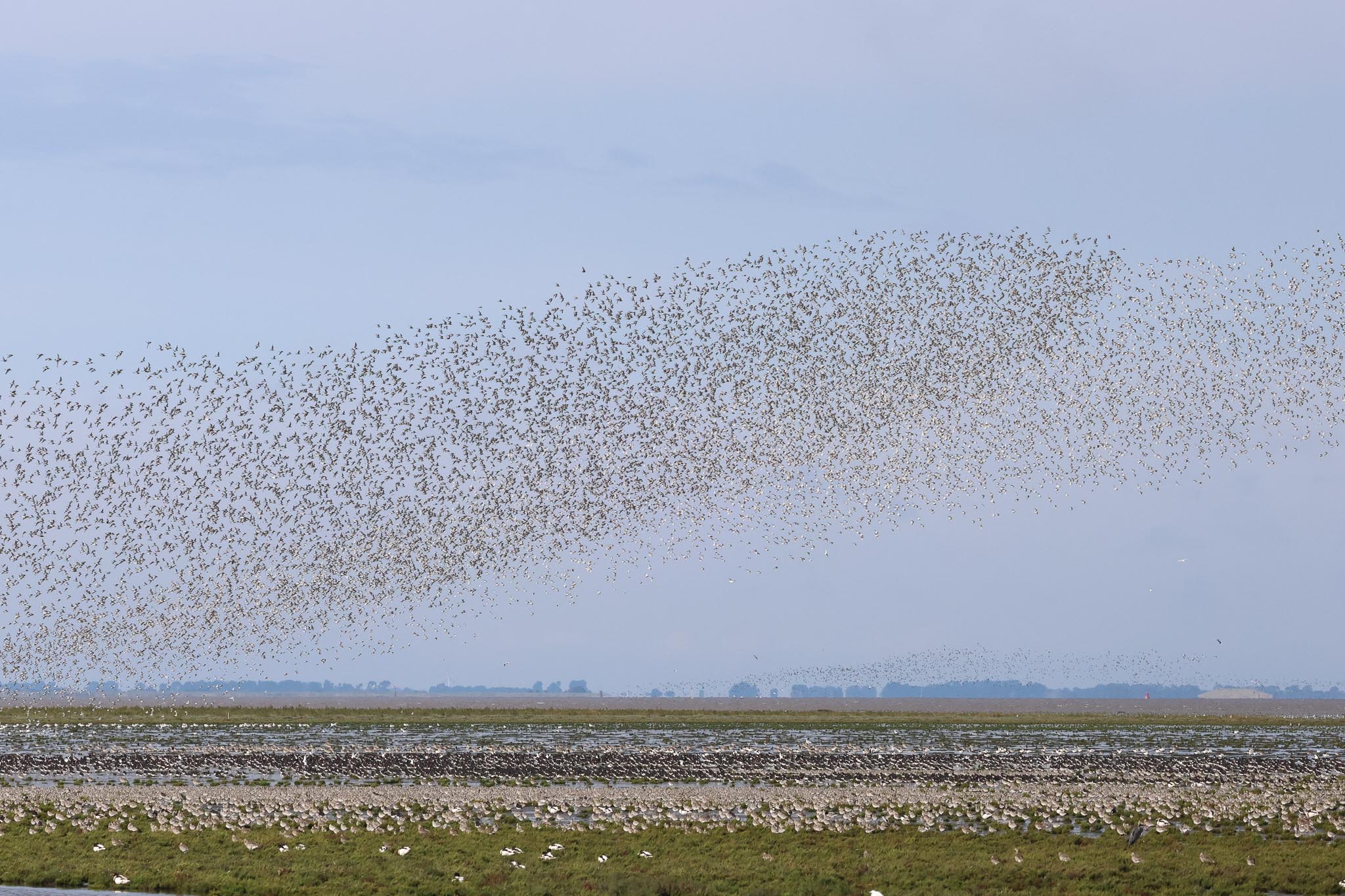
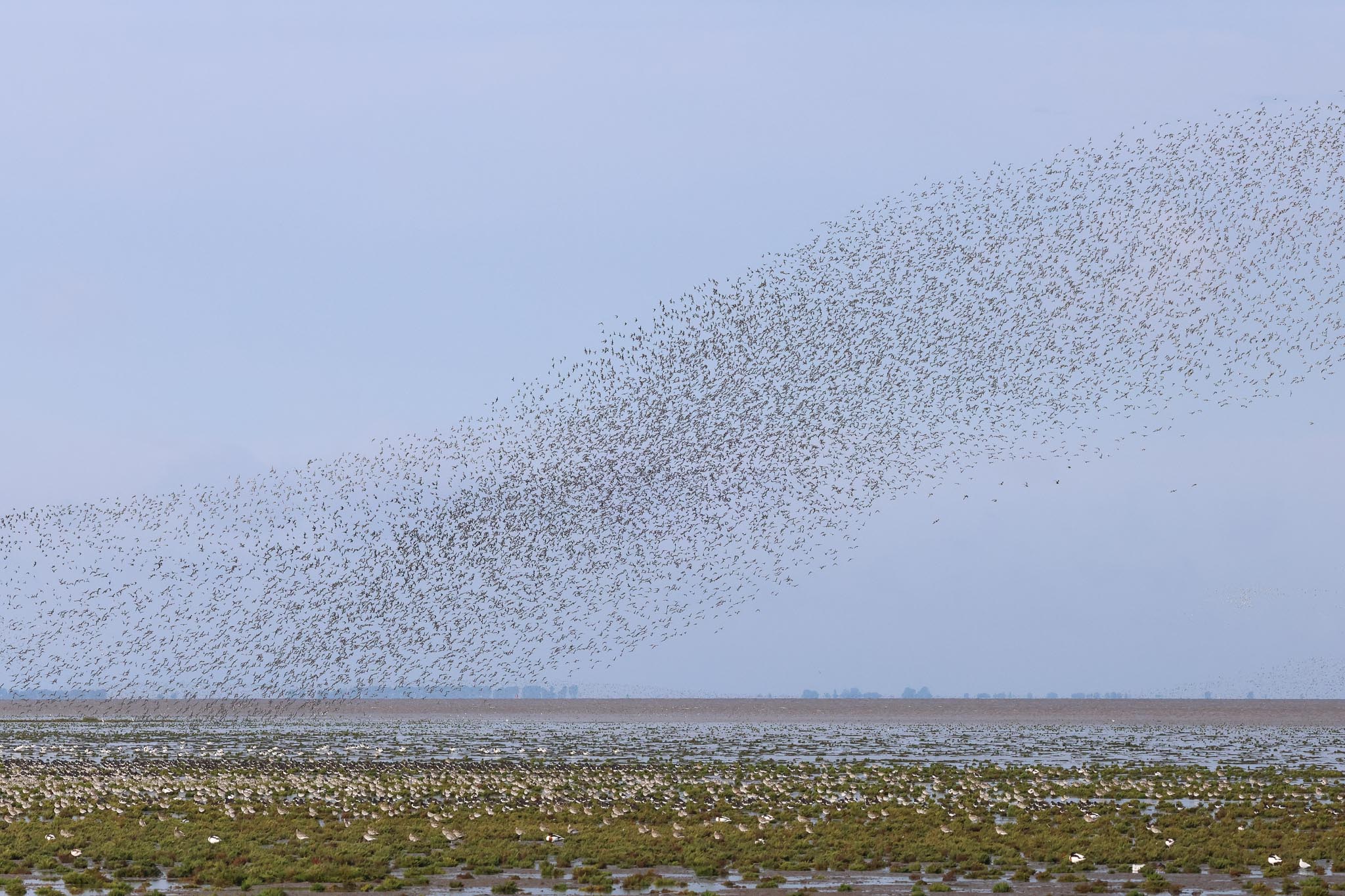
There was quite a bit of mud which had reappeared already and now the waders were spreading out again, we had a closer look at some of them, some smart Grey Plover and one or two Bar-tailed Godwits still largely in their breeding plumage. We picked out a Mediterranean Gull in amongst the Black-headed Gulls out on the mud. There was a steady passage of Swallows this morning – a constant trickle of birds heading south along the shore and a larger flock which paused to feed for a while out over the Wash. We said our goodbyes to them – they won’t be back until next spring.
Everything had settled down again, so we decided to start walking slowly back. There was no sign of the Turtle Doves now, but a couple were walking round out on the beach with their dog. As we got back to where we had started on the seawall, the tide still hadn’t quite got back to where it was when we arrived this morning. A small flock of Golden Plover flew in calling from the fields inland and circled out over the mud.
We headed round to Titchwell next. After making use of the facilities, there was still time before lunch, so we decided to have a quick look for the Yellow-browed Warbler which had been seen yesterday and again this morning. We couldn’t hear it in the car parks, and there were several other people looking, so we decided to head round and try on Fen Trail. We passed two Willow Emeralds and lots of Common Darters enjoying the sunshine. But although there were a few Chiffchaffs calling in the trees, we couldn’t hear anything rarer. Out on the Tank Road, we stopped to listen again, but all we could hear was a typically elusive close Cetti’s Warbler hiding in the sallows and a Blackcap tacking.
Patsy’s Reedbed was very quiet – a small group of roosting Black-tailed Godwits and a single juvenile Ruff with them. The Autumn Trail is open at this time of year, so we decided to have a quick look round at the back of the Freshmarsh – there were more Avocets and Godwits, a few distant Golden Plover and Ruff, but no sign now of the Little Stint which had apparently been on this side of the Freshmarsh here first thing.
We had definitely earned our lunch now, so we made our way back to the picnic area. We could hear Long-tailed Tits calling in the trees nearby, so listened very carefully, but there was still no sound of anything resembling a Yellow-browed Warbler while we ate.
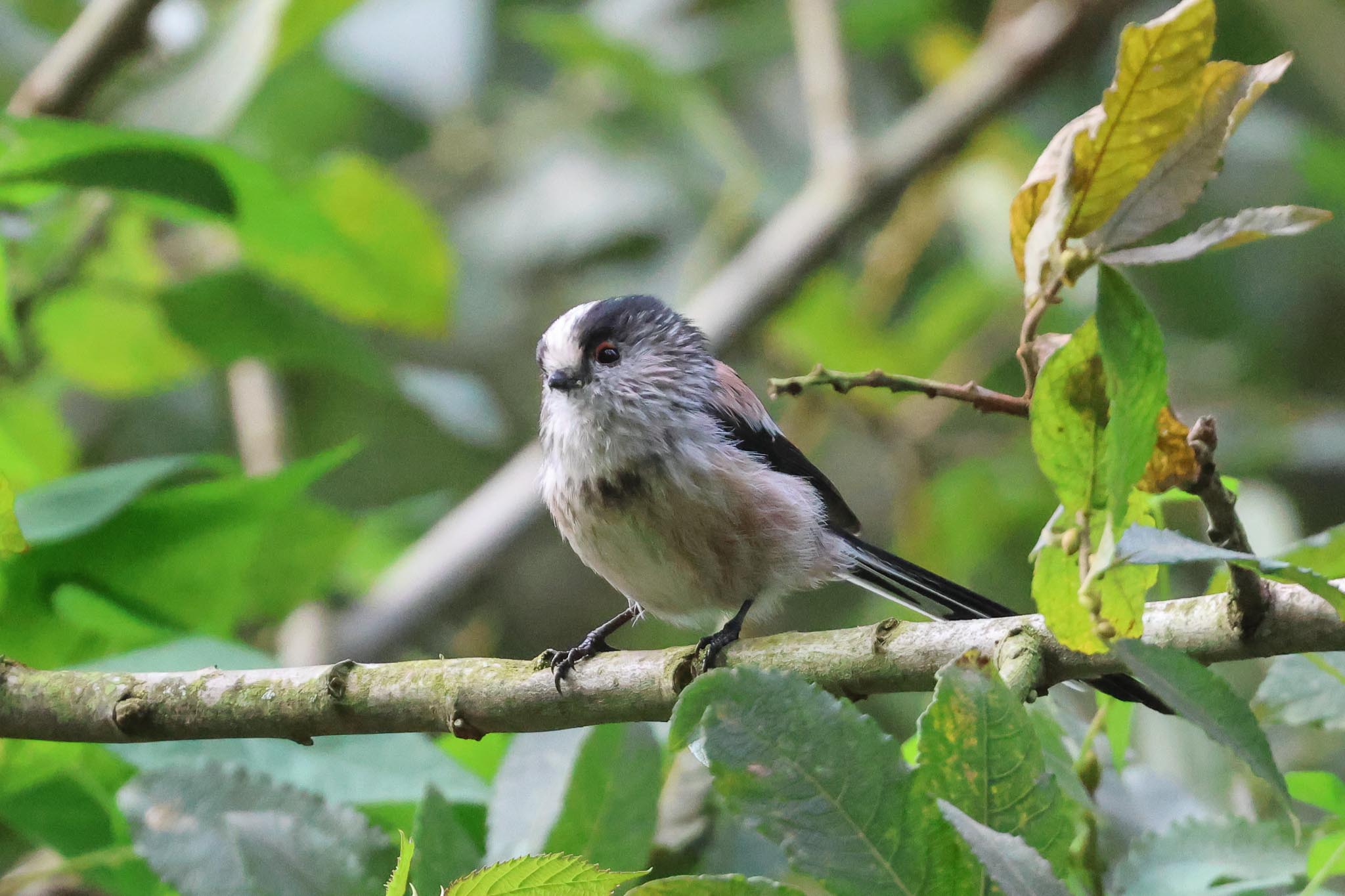
We had an early finish scheduled today, after the early start, but we still had an hour or so before we had to head back, so we thought we would have a quick look at the Freshmarsh from the main path. We were just walking up towards the start of the reedbed when we just caught the sound of a bird calling in the trees. It wasn’t easy to hear, with two US Air Force jets just at that moment chasing each other round and round low over the reserve making a dreadful noise, but we immediately stopped to see if we could hear it again. After a few seconds it did, and it was the Yellow-browed Warbler!
We walked back a short way and cut in along the start of Meadow Trail. One of the reserve staff was on the boardwalk and had heard the Yellow-browed Warbler too, in the sallows. There was a flock of Long-tailed Tits in here, along with Chiffchaffs and Goldcrests, but we managed a quick view of the Yellow-browed Warbler in the trees before the flock moved in a little deeper. We tried to follow them, and they came back out and across the main path, dropping down into the trees in the ditch the other side, but the Yellow-browed Warbler had gone quiet now. Eventually, they crossed back over the path and disappeared into the trees towards the Visitor Centre.
We were running out of time now, so we headed out for a very quick look at the Freshmarsh. A Common Pochard on the Reedbed Pool as a late addition to the trip list. We stopped before Island Hide, where we could hear Bearded Tits calling in the reeds, but it was still rather windy and they were keeping well down out of views. There were several Avocets out in the Freshmarsh, where they were trying to feed up to their bellies in the water – the water level here too has gone up a lot after the recent rain.
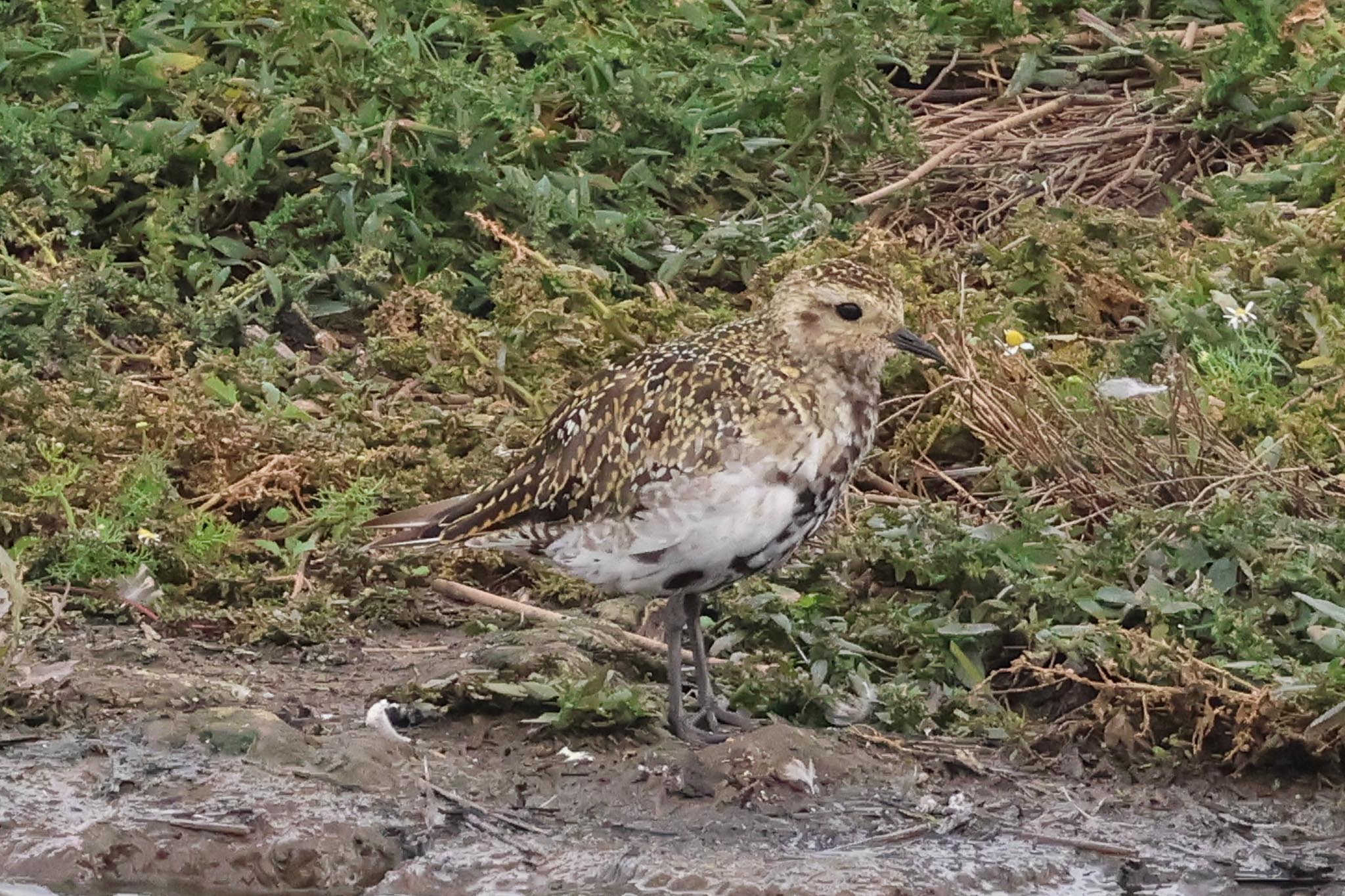
A small flock of Golden Plover flew up from beyond the hide and circled round several times before dropping down again. We walked a little further, up to the bund, and got the scope on them, looking particularly golden in the afternoon sunshine. Another lone Golden Plover was preening on the small island right in front of us, before it got chased off by one of the Ruff. There were at least four Ruff on the edge of the island – two white-headed winter males, a grey winter male and a much smaller brown juvenile female. None of them looked alike!
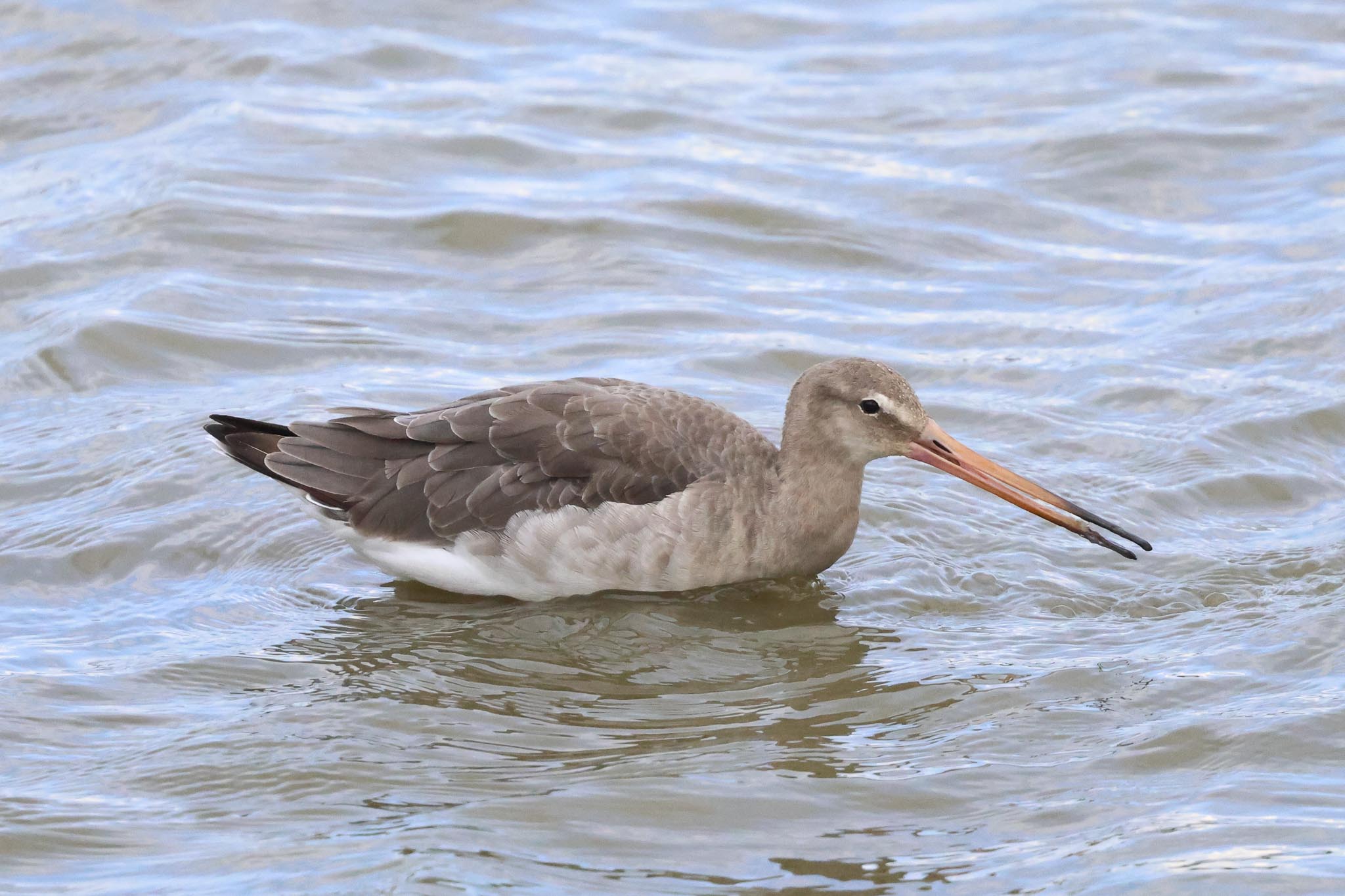
There were several Black-tailed Godwits feeding just beyond the reeds right below us too. It seemed a good way to wrap up our three days, watching the waders here in the sunshine. We looked behind us, and over towards Holme we could see black clouds and a flash of lightning. There were more dark clouds to the south, heading our way. The forecast thunderstorms were approaching. Thankfully, it was time for us to head back anyway, and we got back to the minibus before the rain arrived. As we headed back inland, we drove into torrential rain – perfect timing!
















